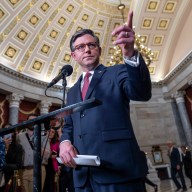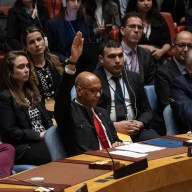 Filmmaker Joe Swanberg rarely has time for acting these days, but he does put in a performance in the horror film “The Sacrament.”
Filmmaker Joe Swanberg rarely has time for acting these days, but he does put in a performance in the horror film “The Sacrament.”
Credit: Getty Images
Since the mid-aughts, Joe Swanberg has been one of the more prolific of the truly independent filmmakers that were not always accurately lumped together under the name “mumblecore.” Some have gone on to bigger things, but Swanberg has stayed the same, crafting tiny, intimate, largely improvised and formally adventurous films like “Hannah Takes the Stairs,” “Nights and Weekends” and “All the Lights in the Sky.” With last year’s “Drinking Buddies,” he gently dipped his toe in the world of more “polished” indie fare, using tripods and name actors, like Olivia Wilde, Jake Johnson and Anna Kendrick. He does it again with “Happy Christmas,” in which Kendrick plays a disastrous woman who shacks up with her brother (Swanberg) and his wife (Melanie Lynskey). But, Swanberg insists, this one’s a bit closer to his older movies.
What was the motivation to return to the scale of “Drinking Buddies” rather than return to tiny micro-budgeted films?
“Drinking Buddies” was such a huge creative challenge for me, and such a big change from what I had been doing up through “All the Light in the Sky” that I appreciated being pushed and being forced to solve bigger kinds of problems — work with a crew and things like that. But with “Happy Christmas” my question was: Can I take the lessons I learned from “Drinking Buddies” and the technical challenges of that movie and then apply them to something that felt more like an “All the Light in the Sky”-type shoot, with a smaller crew and a more intimate feeling? I’m finding that I’m curious about doing both things in my career.
Most of your films have been about people in their 20s. Here it’s about a young family.
There’s something about making a movie about people in their mid-20s that limits the audience. Once you get married and have kids and things like that, those concerns are less interesting to you. I’ve always wanted the characters [in my movies] to grow up with me. Hopefully if I’m making movies in my 50s the characters are in their 50s, and if I’m making movies in my 80s the characters are in their 80s.
What about working with professional, famous actors?
I’m very selective about who those people are. It’s been very fun and easy because, especially right now, nobody is coming to do one of my movies to get famous or make money. They’re there because they want to be there, which already makes my life a lot easier. They’ve heard about the process or they’re curious about doing something small like this. And they’re really good. Anna Kendrick’s really, really talented. Melanie Lynskey’s really, really talented. Mark Webber’s really, really talented. I get to show up to set every day and just talk to people that are very good at what they do.
It’s different than when I was working with non-professional actors early in my career. The reason why I started this improvised process was because I did not want to give those people lines. I didn’t want to take my friend who worked at a coffee shop and turn him into a dramatic actor. I just wanted him to be able to play a guy who works at a coffee shop, who speaks with his own voice. Now that I’m working with actors who are very good at doing lines, I’m finding that I still appreciate improv, because these actors are so smart and they’re often not given a chance to be smart. The bigger an actor gets the less opportunity they have to do that.
 The cast of “Happy Christmas” —left to right, Joe Swanberg, Melanie Lynskey, Swanberg’s kid, Anna Kendrick and Mark Webber —hang out.
The cast of “Happy Christmas” —left to right, Joe Swanberg, Melanie Lynskey, Swanberg’s kid, Anna Kendrick and Mark Webber —hang out.
Credit: Magnolia Pictures
You designed “All the Lights in the Sky” intimately with lead actress Jane Adams. Was this collaborative in similar ways?
My conversations with Melanie and Anna started months before we shot the movie. They’d be via text messages or emails — us saying, “Hey, I’m thinking about this…” “I had this idea today, what do you think?” There was a back-and-forth going on. It’s how I like to work. I want five people solving problems rather than just me solving problems. And I want their different perspectives to have space in the movie. They always make it a lot better and they always have different ideas than I would have. So even if I write an outline that charts the story arc of the movie, I want Melanie to be able to say, “That doesn’t make sense to me. I actually don’t think I would do that.” By keeping it loose I’m inviting the actors into that process and I’m giving them the chance to really own it in a real way other than do mere window dressing. They could rebuild the house, not just put curtains up.
Independent cinema has evolved so much since the ’80s. It’s easy to make movies, but then hard to get them noticed.
It’s the best time I could imagine to be making the kinds of movies that I’m making, because there are so many options now for getting people to see them. But the challenge remains the same: How does it stick? Just because the movie is up on iTunes doesn’t mean people are watching it. That’s still the same challenge. An audience that wants to see it can find it now. How do you get people who don’t know they want to see it to know of its existence? Money is still the best way to do that [Laughs], which is in short supply, unless you can spend $70 million on an advertising campaign.
What are some other ways indie filmmakers can get their films seen?
Festivals are still really important. And any kind of word of mouth is important. I think that a movie like “All the Light in the Sky” will end up being seen by a lot of people. It just takes a lot longer. People are still telling me all the time that they just saw “All the Light in the Sky,” which means I know it’s still spreading around. It hasn’t slowed down. It’s just on a much more gradual path than “Drinking Buddies,” where there was a concerted effort to get people to see it when it opened.
Read our interview with “Happy Christmas” star Melanie Lynskey here.
Follow Matt Prigge on Twitter @mattprigge
















